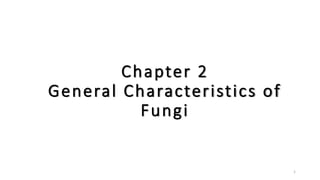
Chapter 2.pptx
- 1. Chapter 2 General Characteristics of Fungi 1
- 2. Diverse and Widespread but adapted to dark, moist environments Closer to animal than to plants Over 100,000 species known Range from single celled (microscopic e.g. yeast) to those that have fruiting structures (eg. mushrooms) Kingdom Fungi divided into five main phyla based on the way they reproduce and molecular biology Chytridiomycota, Zygomycota, Ascomycota, Basidiomycota and Deutromycota (Imperfect Fungi) 2
- 3. 1. Most fungi are multi-cellular eukaryotes; but, a few are unicellular like yeast 2. Fungi are non-motile 3. Most are heterotrophic and consume organic matter. They lack chlorophyll A. Those that obtain nourishment from non-living (dead) hosts are called saprophytes B. Those that obtain nourishment from living hosts are called parasites 4. Most fungi are decomposers that produce powerful digestive enzymes that they introduce into their immediate environment to break down organic matter A. They can destroy and damage stored food and goods B. They can damage live timber C. In partnership with bacteria, fungi are considered the earth's decomposers 5. In the vegetative condition, the fungus body (thallus) is called a mycelium 6. The mycelium is the food-absorbing portion of the fungal body cross walls 3
- 4. 7. The mycelium is actually a network of filaments called hyphae 8. There are 2 kinds of hyphae A. Septate -hyphae that are divided into successive compartments by cross walls or septa B. Coenocytic (or non septate) -hyphae that are continuous and are without cross walls 9. Unlike plant cells, fungal cell walls contain chitin rather than cellulose (recall chitin is found in the exoskeleton of insects and other arthropods) 10. The energy reserves of fungi is not starch -like plants; but, is glycogen -like animals 11. Reproduction is by motile -or non-motile spores that may be produced sexually or asexually 4
- 5. 12. Some uses of fungi A. Baking B. Cheese production C. Brewing of beer D. Wine making 13. There are approximately 200 species of edible fungi and about 70 poisonous species 14. Fungi include over 100,000 species 15. Fungi are found in a wide variety of habitats; but, seem especially adapted to dark, moist environments 5
- 6. 16. Fungi play an important role in ecosystems, decomposing dead organisms, fallen leaves, feces, and other organic materials. This decomposition recycles vital chemical elements back to the environment in forms other organisms can assimilate. Most plants depend on mutualistic fungi to help their roots absorb minerals and water from the soil. Humans have cultivated fungi for centuries for food, to produce antibiotics and other drugs, to make bread rise, and to ferment beer and wine chitin (chitin synthase) is a target for the polyoxin antibiotics that are used against fungi 6
- 7. Fungi are haploid (having a single set of unpaired chromosomes), whereas the other major groups of eukaryotes are diploid (containing two complete sets of chromosomes, one from each parent) Fungal cell membranes contain ergosterol, whereas animals have cholesterol and plants have sitosterol and other 'phytosterols'. Several antifungal drugs (e.g. ketoconazole) used in human therapy act by blocking ergosterol synthesis. The antifungal antibiotics (e.g. nystatin, amphotericin B) combine with ergosterol in fungal membranes. And several fungicides used for plant disease control act by disrupting specific steps in the ergosterol synthesis pathway. Fungi synthesise the amino acid lysine by a unique pathway, different from that of other organisms. Fungi have characteristic soluble carbohydrates (the disaccharide trehalose and polyhydric alcohols like mannitol and arabitol) and storage compounds (e.g. glycogen), differing from those of most plants and animals. 7
- 8. Fungi have several characteristic ultrastructural features, such as plate-like cristae in the mitochondria (like animals), and tubular unstacked Golgi cisternae (unlike animals or plants). The microtubules of fungi have unique binding affinity for anti-tubulin agents. In particular, fungal tubulins bind to the antibiotic griseofulvin (used to treat some fungal infections of humans) and to the benzimidazole fungicides (used widely for control of fungal pathogens of plants). Finally, fungi differ from other organisms in a range of biochemical and molecular features such as the regulation of some enzymes, some aspects of mitochondrial codon usage, etc. 8
- 9. MORPHOLOGY OF FUNGI 1. Yeast 2. Yeast-like 3. Mold (hyphae) 4. Dimorphic Fungi 1. YEASTS 1. Unicellular organisms 2. Round or oval fungi that bud or pinch off 3. Growth resembles bacteria 4. Much larger than bacteria 2. YEAST-LIKE (PSEUDOHYPHAE) – Candida /Candida albicans parasitizes a host using its Pseudohyphae. • Budding yeast with septum. • The septum has formed between the daughter bud and the mother cell. 9
- 10. 3. HYPHAE (MYCELIUM) • Multi-cellular filamentous structures. • Cylindrical, branching filaments composed of tubular cell. • wall filled with cytoplasm and organelles • A mass of hypahe is called Mycelia. • Hyphae 1. Septate – filaments have crosswalls or septa. Ex. Aspegillus 2. Aseptate – filaments lack crosswalls; also called coenocytic. Ex. Mucor Cont. 10
- 11. Fungal Hyphae Cells 1- Hyphal wall 2- Septum 3- Mitochondrion 4- Vacuole 5- Ergosterol crystal 6- Ribosome 7- Nucleus 8- Endoplasmic reticulum 9- Plasma membrane 10- Golgi apparatus 1 2 3 4 5 6 7 9 8 10 11
- 12. Cont. 4. DIMORPHIC FUNGI (FUNGAL DIMORPHISM) • Yeast • (Parasitic or Pathogenic Form). • Seen in human tissue, exudates, or if cultured in an incubator at 37 °C. • Mycelium • (Saprophytic or Mold Form). • Form observed in nature or if incubated at 25 °C. • Conversion to the yeast form essential for pathogencity. 12